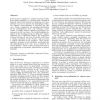Free Online Productivity Tools
i2Speak
i2Symbol
i2OCR
iTex2Img
iWeb2Print
iWeb2Shot
i2Type
iPdf2Split
iPdf2Merge
i2Bopomofo
i2Arabic
i2Style
i2Image
i2PDF
iLatex2Rtf
Sci2ools
AUSDM
2006
Springer
2006
Springer
Accuracy Estimation With Clustered Dataset
If the dataset available to machine learning results from cluster sampling (e.g. patients from a sample of hospital wards), the usual cross-validation error rate estimate can lead to biased and misleading results. An adapted cross-validation is described for this case. Using a simulation, the sampling distribution of the generalization error rate estimate, under cluster or simple random sampling hypothesis, are compared to the true value. The results highlight the impact of the sampling design on inference: clearly, clustering has a significant impact; the repartition between learning set and test set should result from a random partition of the clusters, and not from a random partition of the examples. With cluster sampling, standard cross-validation underestimates the generalization error rate, and is deficient for model selection. These results are illustrated with a real application of automatic identification of spoken language.
| Added | 20 Aug 2010 |
| Updated | 20 Aug 2010 |
| Type | Conference |
| Year | 2006 |
| Where | AUSDM |
| Authors | Ricco Rakotomalala, Jean-Hugues Chauchat, François Pellegrino |
Comments (0)

